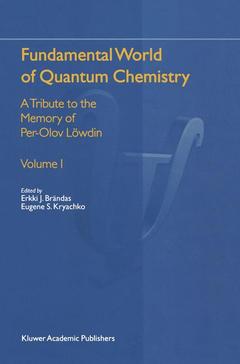Description
Fundamental World of Quantum Chemistry, Softcover reprint of the original 1st ed. 2003
A Tribute to the Memory of Per-Olov Löwdin
Coordinators: Brändas Erkki J., Kryachko Eugene S.
Language: English
Subject for Fundamental World of Quantum Chemistry:
Fundamental World of Quantum Chemistry
Publication date: 11-2012
1373 p. · 15.5x23.5 cm · Paperback
Publication date: 11-2012
1373 p. · 15.5x23.5 cm · Paperback
Fundamental world of quantum chemistry
Publication date: 07-2003
1373 p. · 15.5x23.5 cm · Hardback
Publication date: 07-2003
1373 p. · 15.5x23.5 cm · Hardback
Description
/li>Contents
/li>
Looking at the literature, one finds that, in atomic and molecular physics, comparatively little interest has so far been devoted to the GHF scheme, and the purpose of this paper is to try to focus the interests of some quantum chemists to this rather interesting problem of looking for the "absolute minimum" of the original Hartree-Fock method. (P. -O. Li:iwdin and I. Mayer, Ref. 5, p. 93. ) In view of the complexity of quantum mechanical equations of motion describing atomic, molecular, and solid state phenomena - even when modelling very small systems at the nonrelativistic level within the Born Oppenheimer approximation - one is obliged to introduce rather drastic approximations in order to proceed. The standard approach in the in vestigation of the molecular electronic structure is then to rely on the so-called ab initio electronic model Hamiltonian H, which is defined on a suitable finite-dimensional subspace WN of the infinite-dimensional N-electron component of the Fock space F, and to look for the solu tions of the time-independent Schrodinger equation associated with this model Hamiltonian. The space WN then represents a vector space of N-linear alternating forms, built as the antisymmetrized tensor product of the one-electron space WI, which in turn is spanned by a chosen set of nonorthogonal atomic spin orbitals (ASOs) IXA) == IA)A=I, . . . ,M, defining a given ab initio model.
Per-Olov Löwdin, A Scientific and Personal Appreciation.- The Swedish Doorman, Poem.- The Kind and Personal Influence of Per-Olov Löwdin.- P.-O. Löwdin and The Quantum Mechanics of Molecules.- Symmetry Breaking in the Independent Particle Model.- The Hueckel-Hubbard Hamiltonian and Its Gel’fand Basis.- Different Orbitals for Different Spins, Löwdin’s Idea.- The Pauli Exclusive Principle, Spin-Statistics Connection, and Permutation Symmetry of Many-Particle Wave Functions.- The Length and Breadth of Löwdin-Orthogonalizations.- Correlation Between Position and Momentum. A Phase-Space View.- Harmonic Polynomials, Hyperspherical Harmonics, and Sturmians.- Sturmian Orbitals in Quantum Chemistry: An Introduction.- Molecular Orbital Calculations with Numerically Optimized Orbital Bases.- About Overlap and Chemical Reality.- Quantum Mechanics of Many-Electron Systems and the Theories of Chemical Bond.- Brillouin-Wigner Expansions In Quantum Chemistry A Robust Approach to the Quantum Many-Body Problem in Molecules.- Partitioning Techniques In Coupled-Cluster Theory.- Density Matrix Theory - A Retrospective.- Geometric Aspects of the Theory of Density Matrices and Densities.- Density Matrix Variational Theory: Strength of Weinhold-Wilson Inequalities.- Density Matrices for Electrons with Strong Interactions.- Analytical Hartree-Fock Wave Functions for Atoms and Ions.- The Origin of the Molecular Atomization Energy Explained with the HF and HF-CC Models.- Some Exact Energy Relationships.- Shell Effects in the Relaxation Energy of ls-Core Ionization of Atoms from He through Xe.- Second Order Properties in Tensor Product Space by CI Techniques: Computation of Dispersion Constants.- Non Hermitian Quantum Mechanics: Formalism and Applications.- On The Geometric Phase Effectin Jahn-Teller Systems.- Recent Developments and Applications of the State-Specific Approach to Excited States and Their Dynamics.- Accurate Determination of Partial Rates from Multichannel Wave Function.- Green Function for Elastic Scattering from Open-Shell Many-Body Targets.- Understanding the Rates of Chemical Reactions.- Multichannel Quantum-Classical Diffusion Equations.- Field Energy Density in Chemical Reaction Systems.- Quantum Chemical Methods Applied to Solids.- Superconducting and Spin Gaps in dX2-y2-Wave High Tc Cuprates.- Quantum Theory of Disordered Chains.- Molecular Orbital Theory of the Gaseous Bose-Einstein Condensate: Natural Orbital Analysis of Strongly Correlated Ground and Excited States of An Atomic Condensate in A Double Well.- Model Studies of the Electrophilic Substitution of Methane with Various Electrophiles E (E = NO2+, F+, Cl+, Cl3+, HBr2+, HCO+ OH+, H2O-OH+, and Li+).- Application of MRD-CI for Computing Excited States of Radical Reactions Important for Atmospheric Chemistry: The Electronic Spectrum of Bromine Nitrate BrONO2 in Comparison to Isovalent ClONO2 and Photodissociation of BrONO2 along O-N and Br-O Cleavage.- Nitrous Oxide: Electron Attachment and Possible Scenario for Its Reaction with ns Metal Atoms.- Heavy Element Quantum Chemistry -The Multiconfigurational Approach.- Density Functional Theory Performance in Metal-Containing Systems.- Revival of Parametrized Theoretical Methods for Applied Science Studies: The Example of Transition-Metal Clusters.- Quantum Chemical Calculations of Molecular G-Tensors of Biological Radicals.- Electron Propagator Calculations on the Ionization Energies of Nucleic Acid Bases, Base-Water Complexes and Base Dimers.- Effects of Ionization and Cationization on Intermolecular Proton Transfer Reactions in DNA Base Pairs.- The Origin of Spontaneous Point Tautomeric Mutations in DNA: Löwdin’s Mechanism of Proton Tunneling in DNA Base Pairs.- Modern Quantum Look At The Periodic Table of Elements.- Löwdin’s Remarks on the Aufbau Principle and a Philosopher’s View of Ab Initio Quantum Chemistry.
© 2024 LAVOISIER S.A.S.
These books may interest you

Advances in Quantum Chemistry 193.44 €



